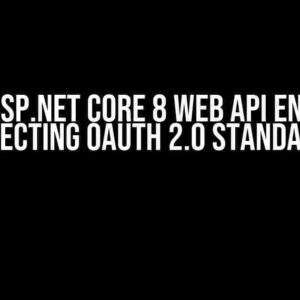Are you stuck in the quagmire of posting complex data types in an ASP.NET Core Razor Page using the MVVM pattern? Fear not, dear developer, for you’ve stumbled upon the right article! In this comprehensive guide, we’ll delve into the intricacies of posting complex data types and provide you with a step-by-step solution to overcome this hurdle.
The Problem Statement
When working with ASP.NET Core Razor Pages and the MVVM pattern, you might encounter issues when trying to post back a complex data type, such as a custom class or a list of objects. The problem lies in the way Razor Pages handle model binding and the limitations of the built-in features.
The Symptoms
- Model state is invalid when trying to post back a complex data type
- Properties of the complex data type are null or empty when bound to the model
- HTTP POST requests fail with a 400 Bad Request error
Understanding the Underlying Causes
Before we dive into the solution, it’s essential to understand why posting complex data types doesn’t work out-of-the-box with Razor Pages. There are two primary reasons:
Limited Model Binding
Razor Pages use a simplified model binding mechanism, which relies on the `BindProperty` attribute to bind form data to the page model. However, this attribute is only capable of binding simple types, such as strings, integers, and booleans. When working with complex data types, this attribute falls short.
MVC vs. Razor Pages
In traditional MVC applications, you can use the `IModelBinder` interface to create custom model binders for complex data types. Unfortunately, Razor Pages don’t support this interface, making it challenging to implement custom model binding for complex types.
The Solution: Using JSON Serialization and Custom Model Binding
Now that we understand the limitations, let’s focus on the solution! To post complex data types in a Razor Page, we’ll employ a combination of JSON serialization and custom model binding.
Step 1: Create a Custom Model Binder
public class JsonModelBinder : IModelBinder
{
public Task BindModelAsync(ModelBindingContext bindingContext)
{
if (bindingContext == null)
throw new ArgumentNullException(nameof(bindingContext));
var request = bindingContext.HttpContext.Request;
var json = await new System.IO.StreamReader(request.Body).ReadToEndAsync();
var model = JsonConvert.DeserializeObject<TModel>(json);
bindingContext.Result = ModelBindingResult.Success(model);
return Task.CompletedTask;
}
}
In this example, we create a custom model binder called `JsonModelBinder` that uses JSON.NET to deserialize the posted JSON data into a complex data type.
Step 2: Configure the Model Binder in Startup.cs
public void ConfigureServices(IServiceCollection services)
{
services.AddRazorPages()
.AddMvcOptions(options =>
{
options.ModelBinders.Add(typeof(JsonModelBinder));
});
}
In the `Startup.cs` file, we add the custom model binder to the MVC options. This registers the binder with the Razor Pages framework.
Step 3: Update the Razor Page Model
public class MyModel
{
[Serialized]
public MyComplexType Data { get; set; }
}
public class MyComplexType
{
public string Property1 { get; set; }
public int Property2 { get; set; }
public List<string> Property3 { get; set; }
}
In the Razor Page model, we add a property of type `MyComplexType` and decorate it with the `[Serialized]` attribute. This attribute indicates that the property should be serialized to JSON.
Step 4: Update the Razor Page View
@page
@model MyModel
<form method="post">
<input type="hidden" asp-for="Data" />
<button type="submit">Submit</button>
</form>
In the Razor Page view, we add a hidden input field to store the serialized JSON data. The `asp-for` attribute binds the input field to the `Data` property in the model.
Step 5: Post Data Using JavaScript
<script>
$(document).ready(function () {
$('form').submit(function (event) {
event.preventDefault();
var formData = {};
formData.Data = @Html.Raw(JsonConvert.SerializeObject(Model.Data));
$.ajax({
type: 'POST',
url: '?handler=MyHandler',
data: formData,
success: function (data) {
console.log('Success!');
}
});
});
});
</script>
In this example, we use JavaScript to serialize the model data to JSON and post it to the Razor Page handler using AJAX.
Conclusion
By following these steps, you should now be able to post complex data types in an ASP.NET Core Razor Page using the MVVM pattern. Remember to serialize your data to JSON, create a custom model binder, and update your Razor Page model and view accordingly. With this solution, you’ll be able to overcome the limitations of Razor Pages and successfully post complex data types.
Troubleshooting Tips
- Verify that the JSON data is correctly serialized and deserialized
- Check the model state for errors and validate the posted data
- Use the browser’s developer tools to inspect the HTTP request and response
- Ensure that the custom model binder is registered correctly in the Startup.cs file
| Tip | Description |
|---|---|
| Use a tool like Fiddler to inspect the HTTP traffic | Fiddler is a powerful tool that allows you to inspect and debug HTTP traffic. It can help you identify issues with the JSON data being posted. |
| Enable debugging in the Razor Page | By enabling debugging, you can step through the code and inspect the model state and posted data. |
I hope this article has provided you with a comprehensive solution to posting complex data types in ASP.NET Core Razor Pages using the MVVM pattern. Happy coding!
Frequently Asked Question
Razor pages can be a real puzzle when it comes to posting back complex data types. In this FAQ, we’ll break down the most common issues and misconceptions surrounding ASP.NET Core Razor pages and complex data type posting.
Q1: Why can’t I post back a complex data type in my Razor page?
By default, Razor pages only bind simple types like strings and integers. To post back complex data types, you need to use a custom model binder or a library like Microsoft.AspNetCore.Mvc.ModelBinding.JsonBinding to deserialize the JSON data.
Q2: Do I need to use [BindProperty] to post back complex data?
No, [BindProperty] only works for simple types. For complex data types, you need to use a custom model binder or a library like Microsoft.AspNetCore.Mvc.ModelBinding.JsonBinding to deserialize the JSON data. However, you can use [BindProperty] on a property that holds the complex data type, but it won’t be enough to post back the data.
Q3: Can I use JsonConverter to post back complex data?
Yes, JsonConverter can be used to convert complex data types to and from JSON. However, it’s not enabled by default in ASP.NET Core Razor pages. You need to configure it in the Startup.cs file or use a library like Microsoft.AspNetCore.Mvc.ModelBinding.JsonBinding to deserialize the JSON data.
Q4: Why does my complex data type post back as null?
There could be several reasons why your complex data type is posting back as null. Make sure you’re using a custom model binder or a library like Microsoft.AspNetCore.Mvc.ModelBinding.JsonBinding to deserialize the JSON data. Also, check that your complex data type is correctly serialized to JSON and sent in the request body.
Q5: Can I post back a list of complex data types?
Yes, you can post back a list of complex data types using a custom model binder or a library like Microsoft.AspNetCore.Mvc.ModelBinding.JsonBinding. Just make sure you’re serializing the list correctly to JSON and sending it in the request body. The custom model binder or library will take care of deserializing the JSON data back into a list of complex objects.








